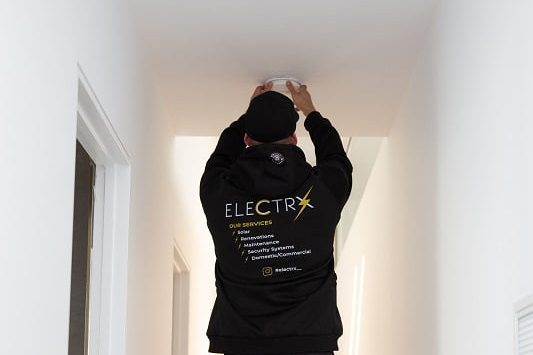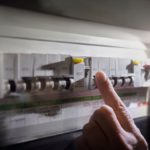Understanding the Reasons Behind Smoke Alarm Beeping
Smoke alarms emit a beeping sound primarily when there is a problem, which could indicate a low battery, an expired sensor, or an internal fault. Even hardwired smoke alarms might chirp when they are functioning correctly, signalling an underlying issue. This sound serves as a crucial warning that your smoke alarm may not be adequately protecting you and your loved ones until the issue is resolved or the unit is replaced. It’s essential to address these beeps promptly to ensure your home remains safe from fire hazards.

Decoding the Meaning Behind Smoke Alarms Chirping
A smoke alarm that continuously chirps is not just a nuisance; it is communicating an important message regarding its functionality. Whether you hear a high-pitched chirp every 30 seconds or a random warning tone in the middle of the night, this beeping indicates that there is an issue that needs your attention. In many homes we visit, this persistent chirping is often the first sign that the smoke alarm is failing to operate correctly. Ignoring these sounds can have serious consequences, so it's vital to understand the underlying causes and take appropriate action.
Let’s explore the reasons this might be happening, the steps you can take to resolve the issue, and when it might be necessary to call in a professional.
Recognising the Distinction Between a Beep and an Alarm
It’s important to understand that a beep, which typically consists of a short chirp every 30 to 60 seconds, serves as a warning. In contrast, a full alarm produces a continuous sound, indicating that it has detected smoke or fire in the vicinity. If you’re hearing the beep but do not see any signs of smoke or fire, this guide will provide you with the information you need to address the issue effectively.
Essential Steps to Take When Your Smoke Alarm Beeps
Here’s a quick checklist to follow when your smoke alarm starts beeping:
- Replace the battery: If your unit operates on batteries or is a hybrid model, ensure you use high-quality batteries for replacement.
- Vacuum the unit: Gently vacuuming the smoke alarm can help remove any dust or insects that may be causing the issue.
- Press the test button: Hold the test button for 5 seconds; it should emit a loud beep and then stop.
- Check the expiry date: If your smoke alarm is over 10 years old, it may be time for a replacement.
- Look for a fault light: Many models feature a red light for battery issues or a yellow light for sensor faults.
If the beeping continues after following these steps, it’s advisable to consult with a licensed electrician. You can easily book our services through our Smoke Alarm Services page or give us a call at 0488 812 237.
Identifying Common Causes of Smoke Alarm Beeping
1. Low Battery Warning Signal
Even hardwired smoke alarms have a backup battery that ensures operation during power outages. When this battery is running low, the unit emits a beeping sound to alert you. This is the most common reason for a smoke alarm to chirp, and addressing it promptly can prevent further complications.
2. Understanding Expired Smoke Alarm Units
Generally, most smoke alarms are designed to last around 10 years. After this period, the internal sensor can lose its reliability, and many alarms will begin to beep to signal that they have reached their end-of-life. You will often find a sticker with the expiry date located on the side or back of the unit, allowing you to easily determine when it’s time for a replacement.
3. Troubleshooting Power Issues with Hardwired Models
For hardwired smoke alarms, a loose connection, tripped circuit breaker, or inadequate earthing can trigger a fault beep, even if the green power indicator light is on. If you suspect power-related issues, it’s crucial to have a professional assess the situation to ensure your smoke alarm functions correctly.
4. Cleaning Out Dust and Insects in the Alarm
Dust accumulating inside the sensing chamber of your smoke alarm can lead to confusion and false alarms. Similarly, a spider or flying insect could disrupt the alarm's functionality. In such cases, a quick and gentle vacuuming of the unit using a soft brush attachment may resolve the beeping issue without needing further intervention.
5. Addressing Humidity or Temperature Sensitivity
High humidity levels, such as steam from hot showers, or extreme temperature fluctuations can cause some smoke alarm models to chirp or even trigger false alarms. To prevent these issues, avoid installing smoke alarms near bathrooms or too close to kitchens where cooking activities and boiling water occur. Ensuring proper placement is vital for optimal performance.
Recognising When It’s Time to Replace Your Smoke Alarm
Smoke alarms should be replaced if any of the following conditions are met:
- They are more than 10 years old, indicating the end of their effective lifespan.
- The beeping continues even after you have replaced the battery.
- The alarm fails to respond when you press the test button.
- You notice any damage, cracks, or water staining on the unit.
- You’ve experienced repeated false alarms or malfunctions.
It’s also essential to check if your smoke alarm system complies with current Victorian safety standards. Most homes should now be equipped with hardwired smoke alarms with battery backup installed in key areas for enhanced safety.
For more safety information, you can refer to the Fire Rescue Victoria’s dedicated smoke alarm page.
Comprehensive Smoke Alarm Inspection and Replacement Services
When you contact us for smoke alarm inspection or replacement services, we undertake a thorough process to ensure your safety:
- We test the smoke alarm unit and its power supply to ensure everything is functioning correctly.
- We check the expiry status and all connection points to guarantee proper operation.
- We carefully clean the sensor and housing to remove any potential obstructions.
- We replace the battery if applicable, ensuring it meets high-quality standards.
- We remove outdated units and upgrade them as needed.
- We install new alarms featuring 240V hardwiring and lithium backup batteries for reliability.
- We ensure that the placement of alarms adheres to current recommendations for optimal safety.
All our work is certified with a Certificate of Electrical Safety, and we exclusively use smoke alarm models that comply with the regulations outlined in the Australian Standards register.
Frequently Asked Questions About Smoke Alarms
Is it necessary to hire an electrician for smoke alarm replacement?
Yes, if your smoke alarm is a 240V hardwired unit, hiring a qualified electrician is essential for safe installation. Battery-operated alarms can be replaced by yourself, but any unit connected to mains power requires the expertise of a licensed professional to ensure compliance with safety standards.
What is the average lifespan of smoke alarms?
Most smoke alarms are designed to last for approximately 10 years. After this period, the sensor can become unreliable, making timely replacement critical to maintaining fire safety in your home.
What are the legal requirements for smoke alarms in Victoria?
All homes in Victoria must have smoke alarms that comply with the Building Code. New constructions and major renovations are required to have hardwired smoke alarms with battery backup for enhanced safety.
Can I silence the beeping temporarily without resolving the issue?
Only temporarily. Silencing the unit will not resolve the underlying issue, and the alarm will continue beeping or may fail completely until the problem is addressed. It is crucial to take effective action immediately.
Understanding the Importance of Responding to Smoke Alarm Alerts
A beeping smoke alarm is your home’s way of signalling a need for attention. While it may be easy to dismiss the sound or temporarily silence it by removing the battery, this action can compromise your safety. Your smoke alarm may be the only line of defence against potential fire hazards, so it’s crucial to respond to the beeping promptly.
If your smoke alarm continues to beep, let us take care of the issue for you. We will thoroughly clean, test, or replace components as necessary, ensuring that your home remains adequately protected against fire risks.



It’s interesting how something as seemingly simple as a smoke alarm can communicate so much about our home’s safety. I’ve always found that those chirping sounds we often overlook are really a case of technology trying to keep us informed. It reminds me of the importance of being proactive about safety measures in our homes, not just with smoke alarms but in all aspects of health and security.
It’s fascinating how a simple device like a smoke alarm can have such a profound impact on our safety. Your insights into the meanings behind those incessant chirps resonate deeply with me. Just the other day, I encountered a chirping alarm at a friend’s house, and it turned out to be a classic case of a low battery. It made me reflect on how often we overlook these seemingly minor signals in our lives, both with technology and in our personal well-being.
You’ve raised such an important topic here about smoke alarm functionality and the often-overlooked implications their sounds carry. I can’t count the number of times I’ve been woken up by that persistent chirping in the middle of the night, assuming it’s just a minor irritation. But it’s fascinating to think about how something as simple as a beeping alarm is crucial for our safety.
You’ve touched on a really interesting point about the dual nature of smoke alarms. They can definitely feel like a nuisance in those moments when you’re half-asleep and groggy, but their significance can’t be understated. I had a similar experience recently when my alarm started chirping at 2 AM because the battery was low—talk about a rude awakening. It made me reflect on how easily we can overlook the technology designed to keep us safe.
You’ve really hit the nail on the head with the sound of smoke alarms. It’s interesting how we tend to see those beeping noises as just annoying, yet they play such a pivotal role in our safety. I remember a time when I was deep in sleep and that sudden chirp jolted me awake. In that disorienting moment, I actually thought something was seriously wrong, only to discover it was just a low battery warning. It’s crazy how our minds can jump to conclusions when we’re startled awake.
It’s interesting how often we overlook something as essential as our smoke alarms until they start beeping at us. I can remember the first time I heard that persistent chirp; I was convinced something was seriously wrong. It ended up being a low battery, but it really made me think about how easy it is to neglect these vital safety devices.
What a topic! Smoke alarms really know how to keep us on our toes, don’t they? It’s like having a dramatic roommate who throws a fit every time there’s a slight change in the atmosphere…literally! The beeping can feel suspiciously like they’re trying to tell you about their latest existential crisis. “Chirp, chirp! My battery’s low! Call the fire department! Or better yet, have you checked your life choices lately?”